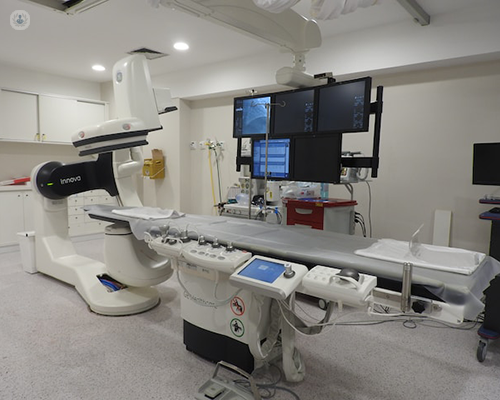Robotic surgery in urology: Detailed insight from a specialist
Escrito por:In this informative guide, revered consultant in urology and robotic pelvic surgery Mr Edward Calleja shares his expert insight on robotic surgery and its applications in the field of urology. As well as revealing the key benefits of the use of robotic surgical approaches, from the perspective of both surgeons and patients, Mr Calleja also discusses how this innovative method differs from traditional forms of surgery in urology.

Which urological conditions can be treated with robotic surgery?
Urology was the first speciality to use the robot to perform intricate surgeries for different conditions some of which are;
- Prostate cancer: Robotic-assisted radical prostatectomy is the most performed procedure with the robot.
- Bladder cancer: Robotic-assisted radical cystectomy is employed for aggressive bladder cancer treatment.
- Kidney disorders: Robotic surgery can be used for partial nephrectomies for kidney tumours, complete removal of the kidney (radical nephrectomy) or pyeloplasty for kidney drainage issues.
Robotic surgery has been embraced in specialities such as ENT, cardiothoracic surgery, general surgery, and gynaecology.
How does robotic surgery differ from traditional approaches?
The main difference between robotic and traditional methods is in the approach. Robotic surgeries are minimally invasive, therefore small incisions, in contrast to the larger ones used in traditional open surgeries. Additional benefits using a robotic system are precision, stability, and ability to access challenging anatomical locations.
What are the main benefits of using robotic surgery for urological procedures?
Enhanced visualisation
The robot's camera provides a 3D, high-definition view, offering superior visualisation of the surgical field.
Greater precision
The robotic arms can filter out hand tremors and move with precise motion. This precision often results in fewer complications. For instance, studies have shown that robotic-assisted laparoscopic prostatectomy (RALP) has a lower rate of positive surgical margins than traditional laparoscopic prostatectomy.
Reduced blood loss
Compared to traditional open surgery, robotic procedures often result in significantly less blood loss. For example, in radical prostatectomies, robotic-assisted procedures reported an average blood loss of 150-250 ml, compared to 600-800 ml in open surgeries.
Less pain
Minimally invasive procedures often result in less post-operative pain and require fewer narcotics during their recovery period.
Shorter hospital stay
A clear example is those patients that undergo robotic-assisted radical prostatectomy who spend one night in hospital whereas traditional open procedures could result in 3-4 days.
How does the use of robotic surgery affect recovery times and patient comfort?
As explained above, robotic surgery often offers a swifter recovery time than traditional methods. The smaller incisions and less post-surgical pain allow early mobilisation this reduces the risk of complications like infections, clots in deep veins and lungs, better breathing as the posture is more upright lowering risk of chest infection.
Of note, the advancement in robotic techniques has paved the way for major urology surgeries to be done as day case procedures, which were previously inconceivable. For instance:
Day case robotic prostatectomy
Robotic-assisted radical prostatectomy, traditionally requiring a short hospital stay of one night, is now being performed as a day case procedure in my centre. The main benefit is that it allows patients to recover in the comfort of their homes, reducing healthcare costs and hospital-acquired infection risks.
Day case partial nephrectomies
Similarly, robotic partial nephrectomies, which involve removing a portion of the kidney, have evolved to the point where some patients can be discharged on the same day of surgery. This approach emphasises the rapid recovery and reduced pain offered by robotic techniques.
Patients often report fewer discomforts, a lower need for pain medications, and a quicker return to their normal activities of daily living, making the overall experience more comfortable.
How does the precision of robotic systems impact the accuracy of urological surgeries?
The robotic camera allows top notch vision. The robotic systems' precision is one of its hallmark features. The enhanced stability and dexterity of robotic arms and the ability to filter out hand tremors allow for intricate manoeuvres that may be challenging with human hands alone. This precision ensures:
- Tissue sparing: Crucial when working around delicate structures or preserving nerve functions, such as in nerve-sparing prostatectomy.
- Reduced risk of complications: Precise movements minimise unintentional tissue damage.
- Improved suturing: Finer stitching can improve wound healing and reduce scarring.
Can you share how robotic surgery has improved the patient experience in urology procedures?
- Shorter hospital stays
- Cosmetic benefits due to smaller incisions
- Less pain and discomfort lowering the need for strong painkillers
- Improved surgical outcomes: Precision often results in better outcomes with fewer complications.
- Peace of mind: Knowing that their procedure involves state-of-the-art technology can provide comfort and confidence to many patients.
If you require urological surgery and wish to schedule a consultation with Mr Calleja, you can do so by visiting his Top Doctors profile


